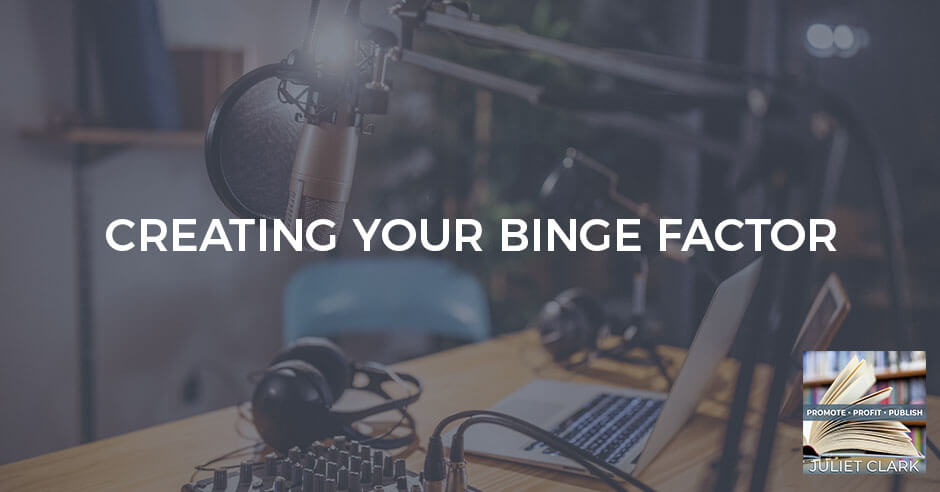
Is your podcast bingeable? With so many podcasts out there competing for space, you have to have that binge factor to succeed. Juliet Clark teams up with podcast innovator Tracy Hazzard to discuss how to enable success for your podcast. Tracy discusses what you need to know before you launch your show and what you need to do to capture listeners. Tune in to learn more and get your podcast ready to go.
—
Watch the episode here:
Listen to the podcast here:
Creating Your Binge Factor With Tracy Hazzard
Welcome back. We have the fabulous Tracy Hazzard with us in this episode. Welcome, Tracy.
Thank you, Juliet. I love being here and talking about all things podcasting and books.
I’m excited. You are about to publish your first book or when this releases, it’s going to be your first book. We’re going to talk about Creating Your Binge Factor book but before we get into it, I want you to give a little background. You created, designed and manufactured a new microphone that’s being released with this and this was all because of some very big interview failures with big players in the marketplace.
The microphone will probably post-release from the digital version of the book, so the digital version will come up first, then the microphone and the print version of the book will come out at the same time, so they’re going to be all partnered together. The reality is that we’re always recording here as podcasters. I own a podcasting company, so the recording is happening all the time but I also used to write a column. I would be asked to do these live interviews. When I would do these live interviews, I’d be like a bag lady with all these microphones, cables and pieces of equipment. It was ridiculous and so often, equipment would fail. That’s exactly what happened.
I was at an event where I could interview Steve Wozniak, which was why I went there. It was a cryptocurrency and blockchain event. I was quite the crypto and blockchain skeptic at that point, so I was surprised they wanted me to cover it for Inc Magazine but I said I would do it because who doesn’t want to meet Woz? That was a dream come true. I had finished reading his book a month earlier, so I was interested to hear why he was going to appear at a blockchain conference.
Podcasting is a marathon. It's not a sprint. Share on XHis interview went fine but I had another chance to interview Gary Vaynerchuk, Gary Vee. Behind the scenes on the stage is where we were set up. It was dark back there. We were running through and doing those quick three-minute interview things where you’re going to get a quote for what’s going to be an article but at least this time, I was going to capture video and my audio.
I had my two microphones, what they call a Zoom device, which is not like the Zoom that we record on the computer but it’s like a big recording device. I had all of that. Us girls wearing dresses to an event have no pockets, so I had to drop the recording device down on the floors so I could shake his hand, hand him a microphone and do this interview.
We did this interview. You can see I talk fast here but Gary talks faster. We’re going back and forth. We must have packed seven amazing questions and answers into three minutes. We finished the interview. He shakes my hand and says, “Great interview. I’ll do another one with you again any time,” and walks away. I pick up my Zoom device off the ground, look at it and the batteries died, so I got nothing from the interview. I was so upset. I called my partner and husband and yelled at him. Poor Tom Hazzard, he got the brunt of all my frustration. I was like, “I feel like a bag lady. You better get me some assistance if you want me to do live interviews. This is ridiculous. This doesn’t work.”
Within a couple of weeks, when I came back from the trip, he shows me this drawing of this amazing microphone that self-records. It has no wires, no cables, nothing. You just hold this lightweight microphone with an LED screen on it. All you do is make sure that you’ve got the battery on. It flashes at you if you screw it up, so if the battery or your recording disc is running out, it flashes at you and gives you all the warnings. Plus, you can hook it to your computer and use it as your regular microphone every single day. It’s amazing. It has been a little bit slower getting it made but it’s on its way to market.
This isn’t the first time that you and your husband have invented something. I want to preface that for all of you. It’s not like one day, he just said, “Here’s the microphone,” and it was amazing. You have invented some other things that you’ve had continuing royalties come in from.
We’ve designed and developed over 250 products that are sold at mass-market retail. Some of them are still selling at Costco, Walmart and Target. It’s what we did for decades. We have over 40 patents that have been issued or are pending on various products in the marketplace. We got notification of a patent that was issued. It was done for a client.

Binge Factor: 98% of podcasters cannot monetize by the traditional model. They don’t qualify.
We’re still trying to figure out which patent was issued. We don’t even know which one it is because there are a few outstanding. No attorney contacted us yet, so we haven’t gotten the letter but we get these little scam letters from people who want us to pay for patent certificates and all kinds of award things that are scammy.
We got one of those before we even got notification from the attorney but that happens all the time for us. This isn’t new for us. We’ve made products. We know how to take them from the beginning to manufacturing to the first run and even to the renovation of the runs, so you know what you might make as a replacement for an item at Costco or Walmart. This is stuff we’ve been doing for a long time under some big brands like Martha Stewart and Better Homes and Gardens.
I did a book for your father-in-law and got the scoop on some early products.
There were some early products before we were good at it. He seems to remember those the best.
These books that are coming out are so important. We’re going to talk about the second one later on in a different episode but people are setting up podcasts. It’s probably the best way out there to communicate your message but people don’t feel confident about it or they get caught up in these big companies that have this very complicated hard-to-do we’re-going-to-take-your money-and-you’re-never-going-to-get-it-done type of situation. Talk to us about this book and why you felt it was important to write it.
It’s so critical about why we are writing it. I can teach you how to podcast. I’ve got a boot camp and we’ve got all this stuff about teaching people how to podcast but the real thing is it is what’s going to make it a successful podcast. We’ve launched over 1,000 shows at our company, Podetize so we see what works and doesn’t work. What we’ve seen is that there’s so much advice in the marketplace that is wrong or worked once and doesn’t work again.
Tom and I are all about repeatable success. What we’ve identified down as a significant part of that is the why you’re doing it and the strategy you use to achieve it. It means maybe a different path for setting up your show. There are choices that you make along the setup process. The setup process is standard. How you start a podcast is you got to have some cover art.
It’s like having a book cover. You got to have your intro and outro music, a voiceover artist and some other things there but the decisions that you make about how long should that voiceover be, how long should that intro piece be, how heavy should the music be and what type of voice should you use are strategic brand decisions and purpose decisions that can help or hurt the success of the show. These are the things that we built into this book as our advisory points.
Anyone can set up a show. We do it all the time for our clients, but the points at which we have to get their input into it where they have to make some strategic decisions for their business and creating what I call the binge factor on their show is what’s going to make the return success or the monetization model that they might want to follow in the future. For many, that’s not an advertisement. It’s how I’m monetizing my voice, my vision and my mission. We wanted to make sure that we put that in a book so that it’s a little bit different from a startup book. All of the little technical details are there but it’s focused on these strategic decision points you need to make.
Let’s get to some of those things you said. First of all, a ton of people out there monetize your podcast. You have to have a listener base before you can monetize. Is that correct? I feel like people are putting the cart before the horse.
Ninety-eight percent of podcasters cannot monetize by the traditional model. They don’t qualify. They’ll never get eleven million listeners like Joe Rogan, which isn’t true. He only has about 2.2 million. The number’s not true. That used to include his YouTube viewers. It’s not his podcast listeners. The market’s overstated as to what it is in terms of that. Your average show is going to do about 150 listeners a month.
I’m above average. I’m so excited.
We want to show up in whatever media type our listener, viewer or reader wants to consume. We want them to have the same basic information, but we want them to be able to consume it where they're comfortable. Share on XThat’s awesome. These are things to celebrate because even shows that only do 100 listeners a month can monetize with tens of thousands of dollars to spend depending on what their show focuses on and how they’re monetizing that. Are they monetizing it with high-value guests who are going to buy high ticket items from them?
Are they monetizing it from listeners but those listeners are going to spend tens of thousands of dollars in investments with them? The model’s different but its focus is different because if you follow Joe Rogan’s model, you’re going to go wrong. His model is all focused on advertising only. If you follow that model thinking, “That’s a success path,” it’s not going to work for you if that’s not the output and the outcome you want.
Picking apart some of that other stuff that you said, a lot of people start it because they want brand recognition but they don’t have a strong brand to begin with or an audience. When you set out with a new podcast, what are those goals there? How can you set realistic expectations for people who think this is going to be an instant gratification process?
If you’re starting and you don’t have what I call a brand platform, meaning that you have a strong website already, a good email list and maybe good social channels on top of that. It’s a three-pronged approach to what we would consider being a platform, a way for you to stand on top of that and have a community ready to listen to you speak.
Joe Rogan already had that before he started. You’re starting from scratch and you want to build that platform. A podcast is a great way to do it because it’s going to build it up in all places at once, so you can go from just recording your podcasts to increasing your YouTube channel with videos. Even if you’re not recording your podcasts on video, you could use audiograms to build a video channel. You can get subscribers who come on board and add to your email list. You can have all sorts of strategies that are going to build that for you but recognize that you’re what we would call a starter platform. You’re a starter brand.
When we are a starter brand, we don’t always know who we want to talk to. We believe we know who we’d like to be our audience but we don’t know who’s going to be attracted to that. We need to treat it like a hypothesis. That’s what I call it. A starter brand is a hypothesis brand. When I started my first podcast, it was in 3D printing.
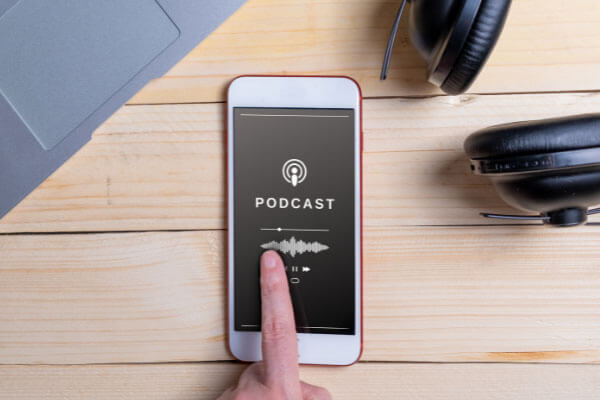
Binge Factor: We believe we know who we’d like to be our audience, but we don’t know who’s actually going to be attracted. We need to treat it like a hypothesis.
I thought I’d have a bunch of 14 to 21-year-old men in their garages. That’s what I thought would be my audience but it turned out to be men and women engineers in their mid-career or retirement who were looking at 3D printing who wanted more information and were interested in what we had to share. It turned out I had a broader and different audience than I thought.
I pivoted to create a broadness in the topics that I was covering in how we handle our website. We expanded it with lessons, other downloads and things we could use to serve them. I expanded until I ended up with 100,000 listeners a month because I used what I was learning there and said, “My focus isn’t over here. It’s this broader demographic.” By keeping your ear to the ground and understanding who’s listening, you can tap into the market that’s there instead of the one you said you wanted.
Occasionally, we found out that my audience was all fourteen-year-old boys in their garage. They have no money and that wasn’t going to be a viable audience for me. I probably would have quit the show quickly but when I found out it was this broader audience who had money to spend and had an interest in the information, it meant that I had a market that was viable that I could tap into.
It turned out to be the best find ever. It turned out I had a better audience than I thought I would. I was using the podcast back then to decide not to do something. Tom said, “Let’s go into this 3D print business.” I was like, “Let’s test it out first. Maybe it’s not a viable market.” We found out it was even more viable than it should have been.
Address the audience as a factor. How do you get more audience visibility? You think you have a very small core audience. I’ve seen ours grow but at first, my target seemed right but we weren’t getting the mass listenership that we do. How do you build on that? Where do you find yourself visible with that?
First off, podcasting is a marathon. It’s not a sprint. That’s the first thing that most people go into and think, “I’m going to get this immediate gratification.” It doesn’t work like that unless you already have an audience. If you already have an audience that you’re serving and you add podcasting to it, you’re going to serve them even more and they’re going to show up and consume some more things because podcasting is an easy consumption media model. That’s going to work for you in that sense but if you don’t have that, it builds and compounds over time.
The more that you show up in the podcasting world, the more podcasts listeners who are out there looking for brand new shows and great information that might match the demographic you’re going after are going to show up for you because you’ve earned their trust. You’ve been there long enough and keep performing week after week. That earned audience comes over time. It doesn’t happen quickly. We typically see it happen at 25 episodes and more. For some people, it is maybe half a year before they start to see that audience growth happening for them.
We like to build in some other areas of gratification. We like to make sure that you’re pulling everything back to your website so you have website growth. That’s one area that we talk about in our book that is very underserved because it’s an SEO conversation, a Search Engine Optimization conversation, which sounds super geeky but at the same time, we know this from being authors that out in the world of authors, if you don’t optimize your listing on Amazon or in places, then readers aren’t going to find you.
It’s the same thing with podcast listeners. If you haven’t done a good job of optimizing for the bots that are the directory community in Apple, Spotify, iHeart and all the different apps that are podcast listening apps, then you’re not getting out there and in front of those listeners to begin with. That’s the number one mistake we see across the board that it goes wrong from all the setups done by a lot of other setup and starter programs or how-to programs there. They’re all wrong in that particular area. They haven’t tapped into that geeky side of things that is necessary to set it up.
Once you get that right, the issue is diving deep into your niche. You start to see your audience is interested in this learning how to 3D print or they liked the designer view that you bring to things and they dive deeper into your niche. That’s what happened to you over time, Juliet. As your show progressed, you dived into a lot of things like talking about book contracts and various areas of things that authors are struggling with making decisions about.
If you haven't done a good job of optimizing for the bots that are the directory community in Apple, Spotify, iHeart and all the different apps that are podcast listening apps, then you're not getting in front of your listeners to begin with. Share on XYou have all of this deep content in this and high authority in it, so you’re the person of choice to come to. You’re the podcast of choice to listen to and that rewards itself. It gets other people to refer them and say, “I heard this on a podcast. Are you struggling with that? You should go listen to Promote, Profit, Published. You should go there and do that.” That helps out.
It does. It’s niching down a little bit more. The other thing is authors, if you’re reading, you need content. That’s the hardest thing I have with authors. They say, “My book is content,” but your book only goes so far. Let’s talk a little bit about the ease of creating this content because podcasting is not only easy but the way that you distribute it hits all three of the learning modalities. That’s a big one here. People can consume it in a way that helps them learn the easiest.
It’s why our corporate name is Brandcasters. We call it brandcasting. What we mean by it is multicasting. You want your brand everywhere. This omnichannel approach to things, which means everywhere is the same, isn’t always right. We don’t always want to show up. We want to show up in whatever media type our listener, viewer or reader wants to consume. We do want them to have the same basic information but we want them to be able to consume it where they’re comfortable, so if I’m a reader, which I am, I try to read about 300 books a year if I can, I want to show up in all the places where people can read my content.
One of the things that drive me crazy is I’m a statistics geek. I love to read FiveThirtyEight because it always has the poll stats and all these different pieces of information, whether it’s sports that you want to look at, politics or whatever. I love the stats and their infographics, but half the time, they do their podcast in video format and not post the transcript, which means I’d have to turn on my video or audio in a place where I’m not ready to do that.
I might be watching my daughter cheer and I don’t want to turn the audio on or plugin. I can’t read it because they didn’t put a transcription or a blog version of it for me. That’s not user-friendly. It’s okay if the day that you air the video, it doesn’t happen, but a week later, you should, by that time, have the article that goes with it. You’re a publication. Those kinds of things frustrate your readers, listeners and viewers, when the consumption model doesn’t match them. They burn out.
We see it all the time in numbers. You see it in your books where you have a short number of people who aren’t going through. For every minute of video, you lose 70% of your audience. In podcasting, luckily, because it’s a private and easy way to consume, some avid listeners consume 70% or more of their episodes that they actively go into and listen to. That’s a great learning and these are avid fans who are going to listen to every word you say. That’s fantastic to know but they also don’t consume the other media types, so if you’re solely a video-focused person, you’re missing the audience. That is why we want a multicast. We want to get it out there in all the media types.
The algorithms know exactly how much you’ve read, listened to and viewed. I’m going to tell you a little story about why it’s important to be a multimedia person. I was at a soccer game a couple of years ago. My daughter was on a very high-level team. I noticed in the finals that none of the moms were watching the game. They were all on their Kindles. They work.
I was listening to mine, cheering and then it got to me. I was listening to Fifty Shades of Grey. I turned around and said, “How many of you guys are reading Fifty Shades of Grey?” They were all like, “How’d you know?” I was like, “Watch your kid’s game.” They were like, “I got it on audiobook.” I was like, “At least pretend you’re paying attention to your kid’s game.”
It’s so true. We have to take a few minutes for ourselves wherever we are and whatever that mode is to do it. I listen to podcasts while I fix my hair and makeup in the morning. It’s my time to consume. A lot of it for me is work, so I’m already working that early in the morning. I’m pumping who I’m going to be interviewing later in the day on my show or I’m checking out some new shows that I heard was good and checking out their style. I’m doing research. My podcast listening is not fun for me anymore. That’s why I read. Reading is me time because it has to be the opposite of that.

Binge Factor: So many of our podcasters are not podcast listeners to begin with. Over about 60% of them are not listeners.
I listen to books because I get so tired of reading.
I am always listening, so that’s why I don’t do audiobooks. I’d rather put the words in front of me for that.
I listen to podcasts and audiobooks nearly all day. My kids are like, “You need a new hobby.” I’m like, “I need noise when I’m working sometimes.”
The interesting thing is that over 60% of my podcasters are not podcast listeners to begin with.
I’ve had this conversation with many audio listeners. I listen to podcasts except for Ben Shapiro on 1.5x speed. He talks so fast. He is like Gary Vee. I have to put it on 1x speed because it’s like the chipmunks. I go through several books a week because I listen to it on 1.7x speed, but the downside of that is when I’m having a conversation a lot of times with people, I’m like, “Speed up.”
I hear there are some video platforms where you can speed it up too and students are doing it to do their lessons with their professors in college. Studies have shown that they’re still retaining. If you go beyond 1.5x speed, you don’t retain as well. That’s the cutoff point. I would think that I talk too fast too. If you want to do 1.5x speed on me, you’re going to go nuts.
That is so interesting because I listen to fiction novels at 1.7x. It’s something I’m learning. I don’t need to retain how so-and-so murdered so-and-so so. Although, I used to read or write fiction. The book is out May 3rd, 2022. It is called Creating Your Binge Factor. You can find it over on Amazon. We’re going to have a bestseller campaign around it. If you’re reading this episode, go buy the book. It’s probably in presale. It’s going to be available on Apple, Google Books, libraries or everywhere you can find it so go buy it someplace and then be on the lookout for that microphone when it comes in. Thanks for being on, Tracy.
Thanks, everyone for reading.
Important Links:
About Tracy Hazzard
 Tracy Hazzard is a seasoned media expert with over 2600 interviews from articles in Authority Magazine, BuzzFeed, and her Inc. Magazine column; and from her multiple top-ranked videocasts and podcasts like The Binge Factor and Feed Your Brand – one of CIO’s Top 26 Entrepreneur Podcasts.
Tracy Hazzard is a seasoned media expert with over 2600 interviews from articles in Authority Magazine, BuzzFeed, and her Inc. Magazine column; and from her multiple top-ranked videocasts and podcasts like The Binge Factor and Feed Your Brand – one of CIO’s Top 26 Entrepreneur Podcasts.
Tracy brings diverse views from what works and what doesn’t work in marketing, branding and media from thought leaders and industry icons redefining success around the globe. Tracy’s unique gift to the podcasting, marketing, and branding world is being able to identify that unique binge-able factor – the thing that makes people come back again and again, listen actively, share as raving fans, and buy everything you have to sell.

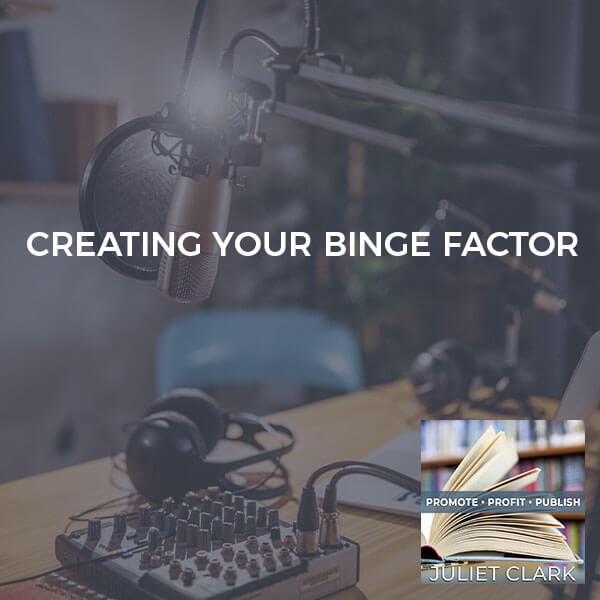


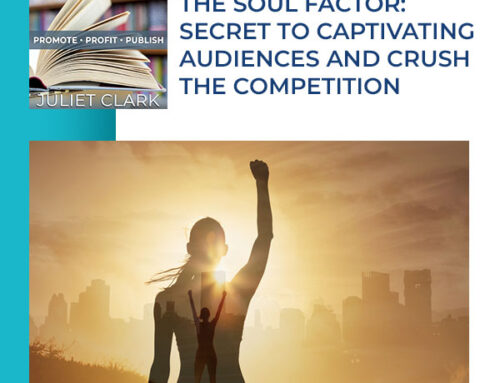
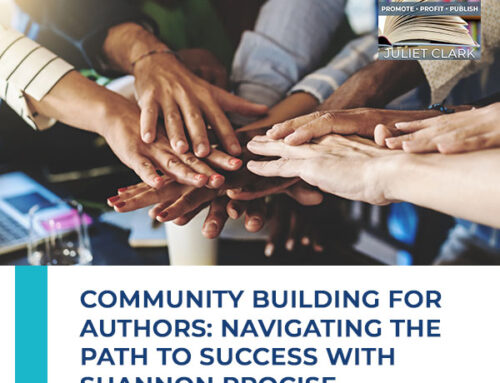
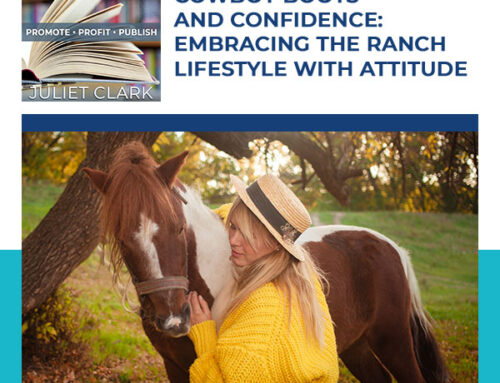


Leave A Comment